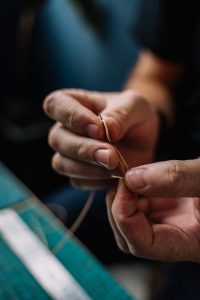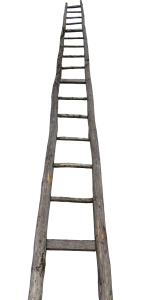20 Slip Stitch
Sheri Deaton
Slip Stitch
A slip stitch, also called a ladder stitch, has many uses and is commonly selected by seamstresses and tailors to discreetly repair a seam, hem, or attach a binding. This stitch is designed to be invisible, so using a thread color that mirrors the color of the fabric is critical.
TIP: For demonstration purposes, consider using a contrasting color of thread to help students see how the seam is created. Teach students to use a complementary color when creating projects, but challenge them to use a contrasting color as they are creating their samples for a class portfolio. When using a contrasting color you can really see the stitch being created and can identify weaknesses and strengths in stitching techniques (Deaton, 2021).

Slip Stitch Strategies
- Thread the needle and make a double knot at the end of the thread.
TIP: Some tailors prefer to tie a knot at the end of one thread instead of two. Consider having students try to create this seam with a double-strength stitch and then one with a single-strength stitch to see if they can identify the differences.
- Iron or finger press the hem of the garment so that the folds are toward the inside seam. Fabric that lays flat will be easier to sew.
- To hide your knot, start on one side of the closure, interesting your needle inside one of the folds. Pull the thread through.
- Bring the needle to the opposite fold and pick up one or two threads of garment fabric close to the hem. Be sure not to catch any threads from the fabric on the outside. Pull the needle through. This stitch should NOT be visible from the “good” side.
- Move ¼” to the left and repeat the stitch. Continue to make slip stitches in the same format, going back and forth between the two folds. Keep stitches evenly spaced.
- Repeat this process and finish the seam with a back-tack knot. Looking at your stitches you will see what looks like a ladder, which is where this stitch gets its nickname.

Hemming it Up
The slip stitch is perhaps one of the more difficult finishing stitches to master. Its versatile uses however make this stitch one worth struggling through. As with many things in life, once you get the hang of the process, you will see great improvement in your proficiency. We climb the ladder of success one rung at a time and that is the approach we should take to the slip stitch as well. One stitch at a time, one practice sample at a time, and this skill will be mastered!

Resources
| Resources | QR Codes |
| How to Sew a Slip Stitch (Ladder Stitch) |  |
| The Slipstitch – Historical Sewing |  |
References
Deaton, S. (2021). Teaching Apparel Production. Presentation.

